What you need to know about growing tomatoes on the balcony
Content
Suitable varieties
When growing tomatoes on the balcony, yield greatly depends on choosing the right variety. If there is a lot of free space on the balcony, then almost all varieties can be planted - undersized, tall. In the case of limited space, it is best to grow miniature bushes, for example, Malysh, Dubok, Cherry varieties. Such varieties will yield small or even small fruits. But all the tomatoes on the balcony are juicy enough, and most importantly, there are a lot of them.
Breeders have developed a balcony variety for tomatoes. It is called "Balcony Miracle". The main feature of the variety is the limited height of the bush. The plant will not be taller than half a meter. Also, the variety belongs to ultra-early ripening, fruits ripen in 85-90 days. Each bush can produce up to 2 kg of fruit. Balcony tomatoes reach 65 grams, the shape of the fruit is rounded, bright red. Perfect for preparing salads and preserving. Growing this variety requires good lighting. Also, it is important that the bushes do not need a garter, which greatly simplifies the care of the plants.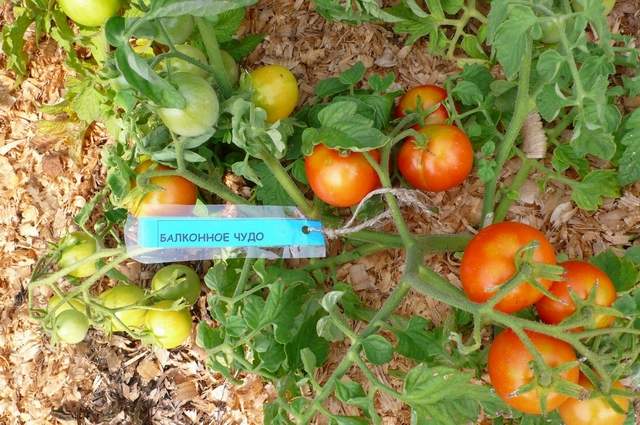
Having planted the varieties White filling or Bull's heart, you can get wonderful juicy tomatoes on the balcony. These varieties are tall, so the containers will need to be moved to the floor. Many amateur gardeners note the varieties Angelica, Zhemchuzhinka, Ballerinka. Balcony variety Florida Petite for growing on the balcony. They have yellow fruits. These plants also bear fruit well at home.
Soil and sowing
Balcony tomatoes will yield excellent harvests if you pay special attention to the selection and preparation of the soil.You can choose both soil and special mixtures for growing seedlings. The soil should be sod and humus in equal parts. If it is necessary to increase the friability, then add peat or sawdust. As a fertilizer, granular superphosphate, potassium sulfate, potassium magnesium, saltpeter or wood ash are used.
Growing tomatoes involves the process of germinating seeds. This is a very important step. This procedure must be done no later than February-March. To do this, soak the seed in warm water (no more than 50 degrees) on a cloth and leave it in a warm place until the sprouts hatch.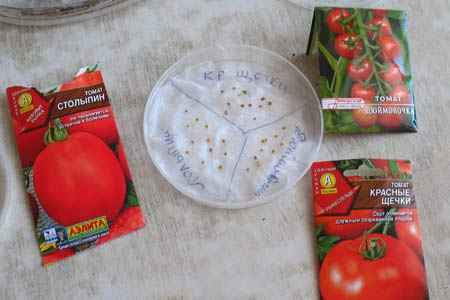
There are two ways to plant seeds. In the first case, fill 200 ml cups with soil and pour boiling water over them. After cooling, we make small depressions and put the seeds there. If the seeds are dry, put 2-3, and if sprouted, then one can be per cup. Holes do not need to be drilled as the soil volume is relatively small and will not absorb enough water. A plastic bottle with a cut-off neck is also suitable as a container. After that, the cups are placed in a warm place and covered with foil. The first shoots should appear in 2-3 days. After that, after 3-4 days, we transfer the crops to a cool place with artificial lighting.Watering is carried out as the topsoil dries out.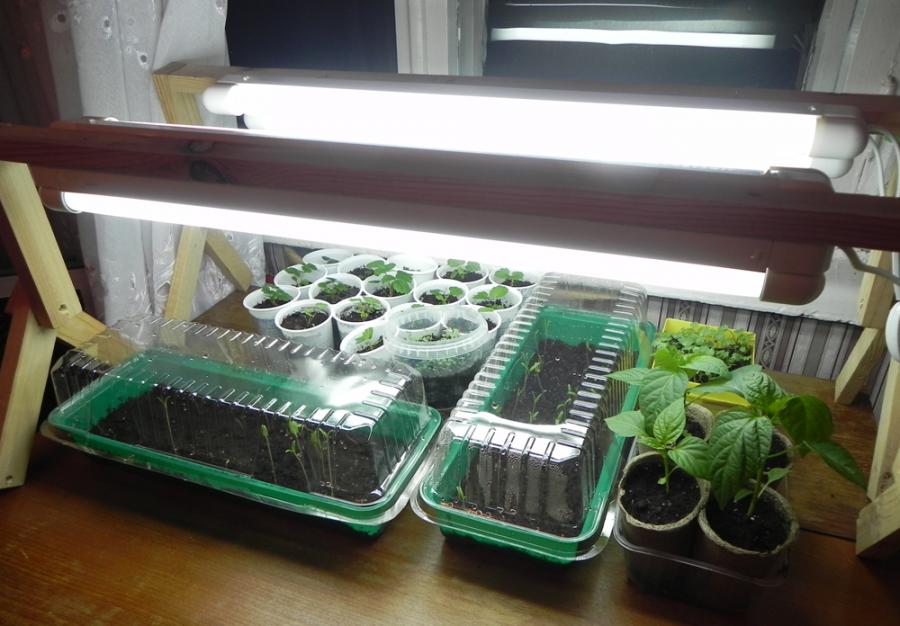
The second method involves the treatment of seeds with a weak solution of potassium permanganate. After that, the seed is wrapped in a damp cloth, placed on a saucer, which is wrapped in a plastic bag. The seeds must be kept warm and moist. Thus, the seeds germinate and lay down one by one in cups with soil. The containers are covered with glass or plywood. After they must be put in a warm place.
After the emergence of plant shoots, the tomatoes are transferred closer to the light. Do not forget about regular watering with water at room temperature.
Care
In April, you need to feed the plants. For this purpose, mineral fertilizers are used. Next, you need to transplant the plants into large containers or buckets. If the container is plastic, then holes must be made in it to drain excess water. Also, in this way, the roots will be better enriched with oxygen. You need to pour soil into a container or bucket.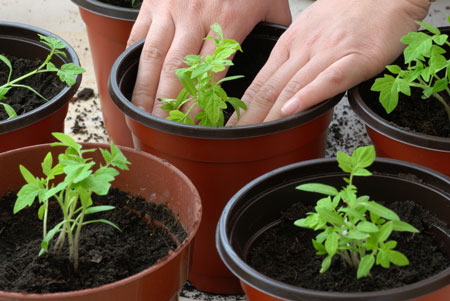 Further, we deepen the roots of the seedlings by two or three centimeters and water. If the variety needs a garter, then we tie the plants to the pegs. After transplanting tomatoes on the balcony, do not touch for 5-7 days. Plants need to take root.
Further, we deepen the roots of the seedlings by two or three centimeters and water. If the variety needs a garter, then we tie the plants to the pegs. After transplanting tomatoes on the balcony, do not touch for 5-7 days. Plants need to take root.
If it is cool on the loggia, then it is best to bring the tomatoes into the room at night, and when the heat comes, you can take all the containers to the balcony.
As the bushes grow, you need to tie them up and add earth to the container. Do not forget about regular watering and fertilizing with mineral fertilizers once a week.At the second stage of development a tomato lateral shoots begin to grow - stepchildren. Usually, the bushes form 2 stems, if the variety is undersized, then three are possible. All extra stepsons are cut off. 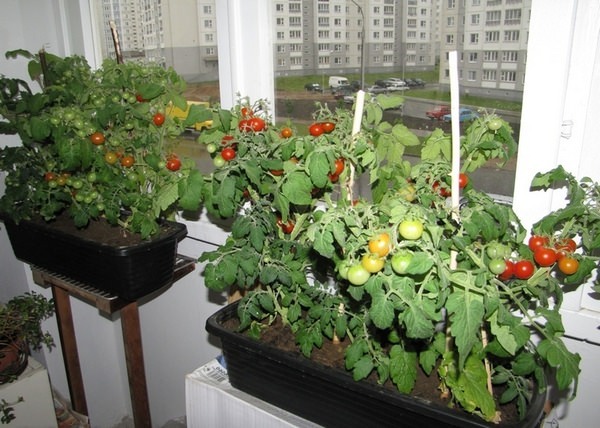 They also prune diseased and yellow leaves. When the fruit brushes are formed, the lower leaves should also be cut off. Sometimes a complete pruning of the leaves is carried out, but this should not be done, since the synthesis of organic materials will be disrupted. Do not forget about the removal of shoots in the leaf axils. If you do not cut the bushes, the plants will be very dense. As a result, inflorescences will not be laid. It is best to prune in the morning and break off the stepsons with your hands so as not to damage the main shoot.
They also prune diseased and yellow leaves. When the fruit brushes are formed, the lower leaves should also be cut off. Sometimes a complete pruning of the leaves is carried out, but this should not be done, since the synthesis of organic materials will be disrupted. Do not forget about the removal of shoots in the leaf axils. If you do not cut the bushes, the plants will be very dense. As a result, inflorescences will not be laid. It is best to prune in the morning and break off the stepsons with your hands so as not to damage the main shoot.
It is recommended to leave four bundles of ovaries on each stem, and pinch the tops of the heads. Balcony tomatoes self-pollinate, but manual pollination can be done for greater efficiency. To do this, you need to lightly shake the flower brushes and tap on the stem. Thus, pollen will spill out from the upper flowers to the lower ones. Also for this purpose, the balcony is ventilated.
At the stage of complete formation of the fruit, the top should be removed, as well as the flowering cysts of the bush. If this is not done, the tomatoes on the balcony will not be able to fully develop. To prevent the fruits from breaking off, you should tie the branches to a stick. It is recommended to pluck a brown tomato, that is, not fully ripe. Tomato fruits will also ripen under room conditions.
Also, do not forget about diseases and pests of tomatoes. A particularly dangerous late blight is a fungal disease that affects all plants and can lead to the death of all plants in a few days. If you see dark spots on the bushes and stems, then be sure to treat the plants with special preparations. Pests such as spider mites and whiteflies can also significantly reduce yields. Remember that tomato diseases and pests can spread to other indoor plants, so it is worth carefully examining the bushes.
Secrets of Successful Growing
The main secrets of how to grow tomatoes on the balcony: firstly, it is worth remembering that the tomato is a thermophilic plant. The best growing conditions for this vegetable - the balcony is located in the south or southeast. If the side is southwest, it is worth considering the possibility of shading the plants. Growing tomatoes is almost impossible on the north side.
In this case, the probability of getting a harvest is very low. If the balcony is not glazed, it is not worth cultivating until April, when constant heat comes. The temperature should not drop below 23 degrees during the day and 13 at night. During the flowering period, plants need a higher temperature. With regard to air humidity, this figure should be in the range of 60-65%. With an excess of moisture, fungal diseases can begin to develop, for example, late blight. The balcony must be constantly ventilated. Watering the bushes should not be carried out more than once every three days. When the soil is waterlogged, the roots can rot. It is important that the water is not cold. From time to time, the soil must be loosened. And add new soil as it subsides.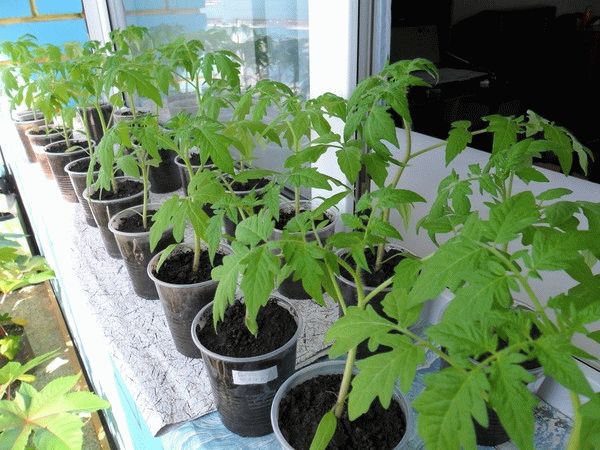
Secondly, for planting plants, special containers will be needed - cups, containers, cut bottles with holes at the bottom. Also, it is recommended to pour expanded clay at the bottom, and only then the soil. One tomato bush should have at least five liters of soil. Seedling boxes are placed on rack supports on the loggia. It is very good if there is a trough in which the slats are placed, and the boxes are already stirred on top.
If the bushes are often watered and fertilized with nitrogenous and organic fertilizers, then powerful plants with coarse shoots will form. But, as a rule, there are few flowers on such bushes and they bear fruit poorly. Top dressing is recommended to be carried out no more than once every 10 days. It is also helpful to spray the leaves with water. Depending on the type of plant, it is worth tying up the branches, as they can break off under the weight of the fruit.
There is one secret to speed up the process of shrub formation and fruit development. It is necessary to cut off the small roots. How to do it? It is necessary to pull up the plant by the lower part of the stem, as if trying to pull it out. Thus, the small roots will be damaged, and the bush will begin to develop faster.
You already know how to grow tomatoes on the balcony. The only thing left to do is to start acting. Do not forget to follow all the recommendations, and then growing tomatoes will bring you great pleasure, and an excellent tomato harvest will be provided.
Video "How to grow tomatoes on the balcony"
Video on how to grow tomatoes without leaving your home. After watching the entry, you will see the technology of planting and growing tomatoes on the balcony.
